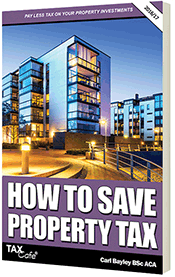Property Tax Relief on your Mortgage Interest
The latest information can be found in our guide:
How to Save Property Tax
The biggest expense faced by most property investors is interest. Thankfully, UK tax law allows you to claim tax relief on your interest but the principles behind the deduction are greatly misunderstood.
The first thing to note is that interest relief operates very differently for companies and individuals. In this article we are going to focus on individuals.
Renting out property is a ‘business’. Like any other business, relief is given for interest on funds borrowed to invest in the business. That’s it. Simple!
Surprisingly, this simple rule is interpreted rather more generously than many people realise.
Simple Scenario
In the simplest case, an investor buys a rental property using a buy-to-let mortgage. The mortgage represents funds invested in the business, so interest relief is available.
Let’s suppose our investor is called Harry and he has bought a property for £100,000 using a buy-to-let mortgage of £70,000. To fund the deposit, as well as his legal fees and the cost of furnishing the new property, Harry has also borrowed a further £40,000 by re-mortgaging his own home. This further sum of £40,000 has also been invested in the business, so Harry may also claim interest relief for this element of the mortgage on his home.
If, for example, Harry previously had a mortgage of £80,000 on his home, he will now be able to claim £40,000/£120,000 (one third) of his mortgage interest, as well as all the interest on his buy-to-let mortgage.
“But”, I hear you say, “Harry isn’t entitled to claim the cost of furnishing the property.” Quite right, but that doesn’t stop the cost of the furnishings from being money invested in the business on which he can claim interest relief.
Withdrawing Capital
In Harry’s case, all of the borrowed funds were invested in his business at the outset. This is not the only way for a property investor to obtain interest relief, however.
Zoe buys a rental property for £195,000 with a buy-to-let mortgage of £120,000. She uses her own existing capital to pay the balance, as well as legal fees and Stamp Duty Land Tax. In total, Zoe has invested £200,000 in her property business, but is claiming interest relief on borrowings of just £120,000. This means that she has invested £80,000 of her own money.
Zoe later re-mortgages the property for £200,000, releasing equity of £80,000. This is the same as the sum she originally invested from her own capital. Whatever she does with this money, she has therefore merely withdrawn her capital.
This means that Zoe can claim full interest relief for the entire £200,000 mortgage on her rental property, regardless of how she spends her ‘equity release’ money. She could pay off the mortgage on her own home, take a world cruise, buy a Ferrari, whatever she likes!
Refinancing Tax Tip
On a more practical level, this principle provides an opportunity for property investors to increase their interest relief, as well as tidying up their personal finances at the same time.
Susan bought several rental properties a few years ago for a total of £250,000, financing them with buy-to-let mortgages totalling £150,000. She currently has an outstanding mortgage of £80,000 on her own home and credit card balances totalling £20,000. As things stand, Susan may claim tax relief for the interest on her buy-to-let mortgages but nothing for the mortgage on her home or her credit cards.
If Susan re-finances her rental properties by increasing her buy-to-let mortgages to £250,000, she will be able to pay off her credit cards and the mortgage on her home and claim interest relief for the entire sum of £250,000.
Remember, any borrowings against rental properties up to the total amount of capital invested in the property business will be eligible for interest relief regardless of where those funds are spent.
The total amount of capital invested in the business will usually be the original cost of the rental properties, including ancillary costs such as legal fees and Stamp Duty Land Tax, plus other capital expenditure, such as the cost of furnishing the property.
Renting Out Your Home
Where an existing property is introduced into the rental business, its market value at that date will represent capital introduced. This applies most commonly to people’s own former homes and inherited property and provides another opportunity for some effective tax planning.
Ian wishes to move out of his current home, worth £500,000, rent it out and ‘downsize’ to a small cottage which he intends to buy for £150,000.
As soon as Ian rents out his current home, he has introduced capital of £500,000 into his rental business. Hence, if Ian mortgages the house for £150,000, he will be able to use the money to buy his cottage and still obtain full interest relief. It doesn’t matter whether he mortgages the house before or after he rents it out.
If Ian had mortgaged the cottage instead, he would not have been entitled to any interest relief.
The Big Catch
As generous as interest relief is for individual property investors, the big drawback is that the interest may generally only be set against rental income, with any surplus being carried forward as a rental loss. There are two main ways around this problem: furnished holiday lettings and using a company, both of which we will examine in future articles.






